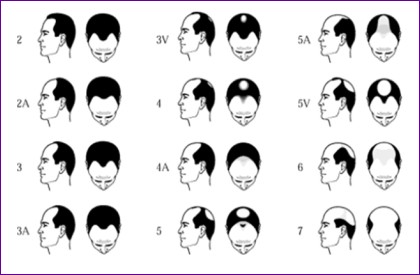|

|
|
THE NORWOOD SCALE
Note: There are many variations in male pattern hair
loss - the following are the most typical
|
|
FOR MEN - MALE PATTERN BALDNESS
Androgeneticalopecia
- commonly known as male pattern hair loss (MPHL) - accounts for more than 95%
of hair loss in men. By the age of thirty-five, 35% of all men will
experience some degree of appreciable hair loss and by the age of 50
approximately 50% of men have significantly thinning hair. Approximately 25% of men who suffer with male pattern hair loss begin the painful
process before they reach the age of twenty-one. Contrary to social belief,
most men who suffer from male pattern hair loss are extremely unhappy with
their situation and would do anything to change it. Hair loss affects every
aspect of the hair loss sufferer’s life. It affects interpersonal relationships
as well as the professional lives of those suffering. It is not uncommon for
men to change their career paths because of their hair loss.
CAUSES
OF HAIR LOSS
Androgenic
alopecia or male pattern hair loss (MPHL) is responsible for the vast majority
of hair loss in men. While there are many possible reasons people lose hair
including serious disease, reaction to certain medications and in rare cases
extremely stressful events, most hair loss is men can be blamed on heredity, testosterone
and age. What male pattern hair loss sufferers are actually inheriting are hair
follicles with a genetic sensitivity to Dihydrotestosterone (DHT). Hair
follicles that are sensitive to DHT begin to miniaturize, shortening the
lifespan of each hair follicle affected. Eventually, these affected follicles
stop producing cosmetically acceptable hair. This process of 'Miniaturization”
causes the terminal follicles to produce 'Vellus' or baby hairs, that are fine,
short and non-pigmented. Male pattern hair loss is generally characterised with
the onset of a receding hairline and thinning crown. Hair in these areas
including the temples and mid-anterior scalp appear to be the most sensitive to
DHT. This pattern eventually progresses into more apparent baldness throughout
the entire top of the scalp, leaving only a rim or 'horseshoe"'patter
n of hair remaining in the more advanced stages of MPHL
A
CLOSER LOOK AT DHT
Dihydrotestosterone (DHT) is a derivative or
by-product of testosterone. Testosterone converts to DHT with the aid of the
enzyme Type II 5-alpha-reductace, which is held in the hair follicle’s oil
glands. While the entire genetic process of male pattern hair loss is not
completely understood scientists do know that DHT shrinks hair follicles, and that
when DHT is suppressed, hair follicles continue to thrive. Hair follicles that
are sensitive to DHT must be exposed to the hormone for a prolonged period of
time in order for the affected follicle to complete the miniaturization
process.
DIAGNOSIS
Typical male pattern hair loss is usually
diagnosed based on the appearance and pattern of the hair loss along with a
detailed medical history, including questions about the prevalence of hair loss
in the family. An experienced
doctor will examine the scalp under magnification with a device called a
‘Densitometer’, in order to assess the degree of miniaturization of the hair
follicles. This assessment is very important when recommending the proper
course of treatment. Some advertised ‘clinics’ might recommend a costly hair
analysis or a scalp biopsy to properly diagnose your hair loss. The only reason to have a hair analysis is
to assess the possibility of poison induced hair loss. Hair analysis may
reveal substances such as arsenic or lead, however, hair loss caused by poisoning
does not present itself in a typical male pattern. Such clinics should be
avoided and the advice of a recommended Hair Transplant specialist who can
properly examine you and help you treat your hair loss, should be sought.
When
considering treatment for hair loss, it is important to understand just how far
hair loss has progressed and this information can be relayed via telephone
or the Internet. It is also important to guard
yourself against misdiagnoses of your condition.
|
|
DIFFUSE PATTERNED ALOPECIA AND
DIFFUSE UNPATTERNED ALOPECIA
Two other
types of genetic hair loss in men, as well as women, not often considered by
doctors are 'Diffuse Patterned Alopecia”' and 'Diffuse
Unpatterned Alopecia', as they pose a significant challenge both in diagnosis and in patient
management. Understanding these conditions is crucial to the evaluation of hair
loss in both women and men, particularly those who are young, when the
diagnoses may be easily missed, as they might indicate that a patient is not a
candidate for hair transplant surgery.
Diffuse
Patterned Alopecia (DPA) is an androgenetic alopecia manifested as diffuse
thinning in the front, top and crown, with a stable permanent zone on the sides
and in the back. In DPA, the entire top of the scalp gradually miniaturizes
(thins) without passing through the typical Norwood stages.
Diffuse
Unpatterned Alopecia (DUPA) is also androgenetic, but lacks a stable permanent
zone and affects men much less often than DPA. DUPA, found more in women then
men, tends to advance faster than DPA and ends up in a horseshoe pattern
resembling the Norwood Class VII. However, unlike the Norwood VII, the DUPA
horseshoe can look almost transparent due to the low density of the back and
sides. Differentiating between DPA and DUPA is very important because DPA
patients often make good hair transplant candidates, whereas DUPA patients
almost never do, as they eventually have extensive hair loss without a stable
zone for harvesting.
|
|

|
|
The
progression of male hair loss in Diffuse Patterned Alopecia (DPA) and Diffuse
Unpatterned Alopecia (DUPA). In DUPA, the sides thin significantly as
well.
|
|
|

